Like all good things in Bali, traditional healers come in a variety of unexpected shapes and sizes. There are traditional healers dedicated to setting broken bones and realigning injured bones.
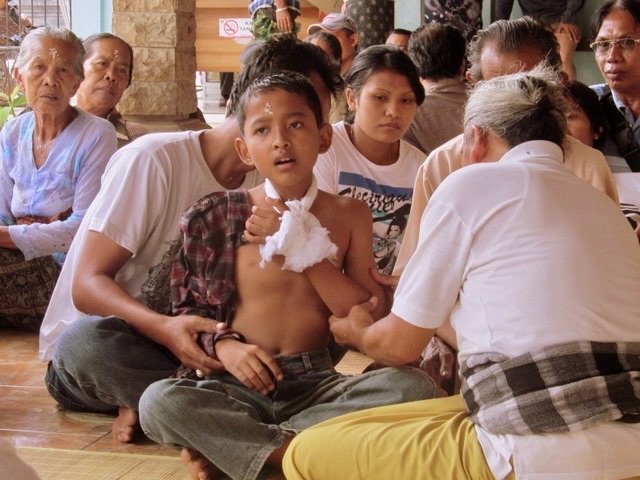
Left: The famous “Bone Man of Besakih”. People far and wide make a pilgrimage to see this Pak Mangku (an honorary title of respect) who resets and fixes broken or misaligned bones. Besakih is arguably the spiritual center of Bali although there are several other location contenders. Besakih’s impressive temple is known as the Mother of all Temples. As a demonstration of his sacred alignment, this Pak Mangku receives patients all day long at his “office” in shadow of Besakih Temple.
Note: I have seen photos of a local who went to a traditional healer with a broken wrist or forearm bone. The photos showed a home-made cast and splint.
These specialized Balians (traditional healers) run the curative gamut. There are Balians who find lost objects and identify unknown thieves. Some have the talent to contact the dead; others can fix internal organs, such as crooked body parts, lumps, or obstructions to blood flow. There are also “rain handlers” who keep the monsoons at bay. Rain handlers are brought in by organizers of major outdoor events (weddings, celebrations, or even political rallies). In contrast, I (Zephyr Carlyle) lived for a few years with American Indian tribes in the arid Southwest of USA. All desert tribes had rain makers and ceremonies to bring on the rain. Without these vital services, crops and livestock would die from drought; people would be thirsty. Here, they have traditional specialists who stop the rain. Only in Bali. Note: While these surprising specialists exist, the Balian bread-and-butter comes from healing patients afflicted with physical, mental or psychic illnesses. The physical practitioners include midwives. Balians may cure patients with illnesses that have a natural, physical origin OR ailments of a psychic, spiritual nature — violations of traditional religious beliefs. Written December 30, 2021
Please note that I may sound like a sycophant (blind follower) but I am skeptical of all healers, traditional and modern. I go for extra-ordinary experiences with an attitude of “sell me – prove it” – especially clairvoyants and psychics. Many outsiders dismiss extra-ordinary healers with a raised eyebrow, chuckle, or worse. I follow the model of Harry Houdini. He knew that there was some. inexplicable powers out there, but most practicioners are bunko artists. He kept trying to contact his dead mother; but wound up disappointed at best with the spiritualists and ouija boards. Do Balians work? Yes — but how? I believe that Balians work, in part, because the doctor and patient fervently believe in this culture and context. Do Balians work because they have a direct link to God(s) and the spirit world? I dunno. I believe there is some power beyond me and these healing folks plug right into it. The proof is in the pudding: [good luck foreign readers] Balian healing works often, especially for physically based illness or those afflicted because of some violation of sacred, cherished religious practices. If you feel you heal – the patient believes it; the Balian cures it. But Balians also heal in ways modern medicine cannot explain. I can testify to my own healing, physical and spiritual (emotional), but it is not because I am Balinese. I admire and am deeply moved by the Balian religion and culture. The rectitude of the Balians attitude and actions of the people reflects the balance in their lives. In contrast, I was not raised in Bali. I am an outsider looking in; raised in Western Christian traditions. I can also testify that the Balian healing has not always worked. I had healing failures among the successes. The Balians could not cure me of several hard-to-reach ailments. That’s okay, the medical doctors did not do any better.
This article will look at two of my recent traditional healers — Balians not mentioned before in this website. After that, there are two sections to explain the religious and cultural fabric in which all these Balians can spin their fantastic healings. One explanation focuses on Bali magic; and focuses on the contrast between the “seen” world and “unseen” world — both of these perspectives are important to the Balinese. This article builds on a related article about traditional healers that was posted this website. The article, “Enter the Balians…..” can be found in the Bali Culture section of this website. The direct link to this first article is: https://templesandtribes.net/wp-admin/post.php?post=1710&action=edit.
Note: the term “Balian” denotes traditional healer; the word “Balinese” refers simply to all things Bali.
Author’s Recent Traditional Healings
Recently, I had treatments by two very different traditional healers. The first was a Balian tenung, a healer who communicates with the departed. The tenung summons up the spirits of deceased relatives. He, or in my case she, may channel the departed if the deceased enters the tenung’s body and speaks through him. As an alternative, the tenung may go into a trance and serve as an intermediary between the living and the dead, in almost a conversation format. The second Balian is harder for me to categorize. A whole range of healers exist in Bali, and I am not familiar with this type – perhaps my ignorance, or not all Balians fit into rigid categories. From the list given in the prior article, “Enter the Balians,…”, this guy was closest to a Balian usada. The Balian usada cures the sick with home-made herbal remedies. Commonly, this Balian makes the herbal remedies from plants he cultivates in his backyards; or that he collects in the fields. The Balian makes potions for internal or external use. He also prepares powdered herbs that can also be turned into a mashed, thick paste by adding a little water. This paste, really an old country cure in called a poultice in the West, is smeared over the affected body part. This paste sit until it dries and the patient lets it remain for an hour or so, if possible, before washing it off.
Balian Tenung – Spiritualist for Contacting the Dead
I travelled to rural Bali, hours from where I live in “urban” Canggu, to explore the beautiful countryside and meet up with the tenung. The countryside reminded me of rural African jungles and tribal life. I went to the tenung’s home on a gravel road and was pleasantly surprised the home had electricity. I was relieved, only because I did not want to hold a seance by candlelight.
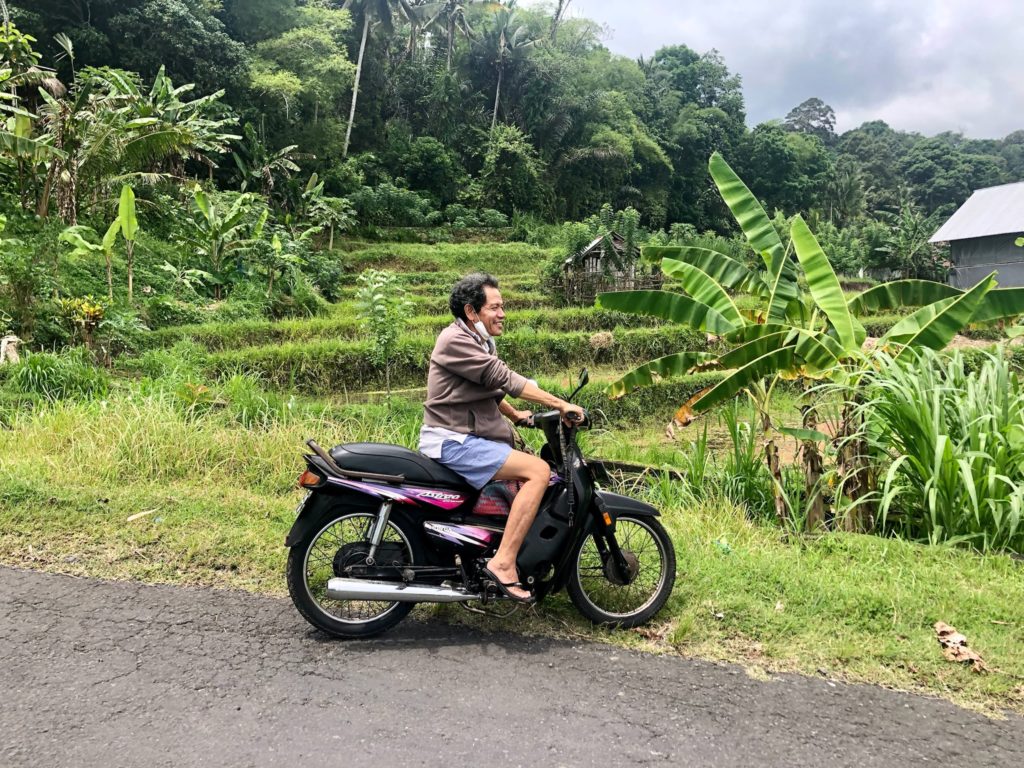
I traveled by car and motorbike through large sections of this rural area, Karangesem, to get to the tenung’s home. I first stayed in town with my friend and healer, Tri. From the main town, I rode on the back of Tri’s small motorcycle to visit the tenung, who lives in the middle of nowhere jungle. This neck of the woods in the above photo is a populated area under cultivation. After a short rest, we are back on the bike and on our way to see the tenung!
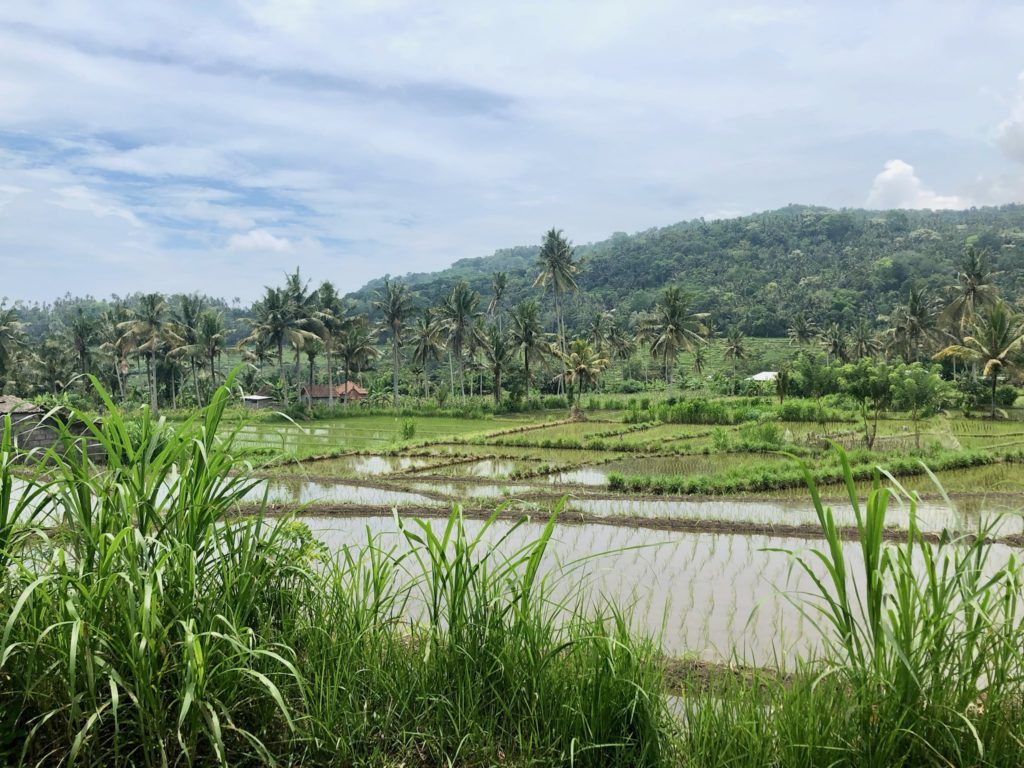
Again, this is a populated area on the way to the tenung. In the foreground are rice paddies. There is no artificial irrigation here. We are in the middle of the rainy season in Bali. These farmers live in the “populated” areas, —but the population density is very low. The far-flung residents clear the land enough to build farms, fields and houses — no stores or schools out here. Once outside these settlements, the jungle reemerges.
The tenung took me into her workspace (below right). She prayed to gods on an alter, waved around lit incense, and blessed herself with holy water. She took the water and followed a simple ritual I had participated in many times in Hindu temples. Usually the priest is the officiant, but a person can do there own ritual cleansing (ritual cleansing with water is also called “ablutions”). Three times, the tenung whisked a little water on her head from a tiny hand broom. She then sipped a little water three times from her cupped hands (right hand over left.) She then took a little water in her hand and splashed it on her face. Afterwards, she took some rice and affixed it to the spot just above, but between, her eyebrows. Now, she was ready to get down to work. She prayed, swayed, chanted, spoke in tongues and seemed to be in a trance. The tenung said she had trouble finding my parents as they died so long ago and in such a far away place — the USA. She finally summoned up my deceased mother and father. She told them I was now living in Bali. They were surprised and angry that I had not told them of my move. She asked if I prayed and talked to my parents on a daily basis. I said no. She said that explained a lot of their anger towards me. Through the tenung, my parents told me they were sorry for all the things that they did wrong. They apologized as they did not take care of me when I was growing up; which was true. I told them I was sorry that I have not honored them after they departed. I apologized for anything I did wrong by them while they were alive. I had no idea what was my wrongdoing, but it seemed to fit the flow of the discussion.
After all was said and done, we all said goodbye. The tenung came out of her altered state. She gave me the same water ablutions that she gave herself at the start of the session. She then gave me some advice. I had to buy an article of clothing for each parent and store it somewhere safe. Before each meal, I had to give an offering to my parents – a tiny amount of food placed on a small section of banana leaf (or plate). I need to pray to my parents before I eat and offer the food up to them. After I finish my meal, I can eat this small offering myself. Furthermore, the tenung did a small ritual and blessed some water, transforming it into holy water. She put the holy water in a glass jar and passed it to me. I was instructed that every day, I should do the ablution using this holy water. These ablutions would cleanse my spirit and honor my parents. The best part about this holy water is that when I run low on the sacred water; just add more water. The remaining sacred water will transform the new addition into holy water. Nice.
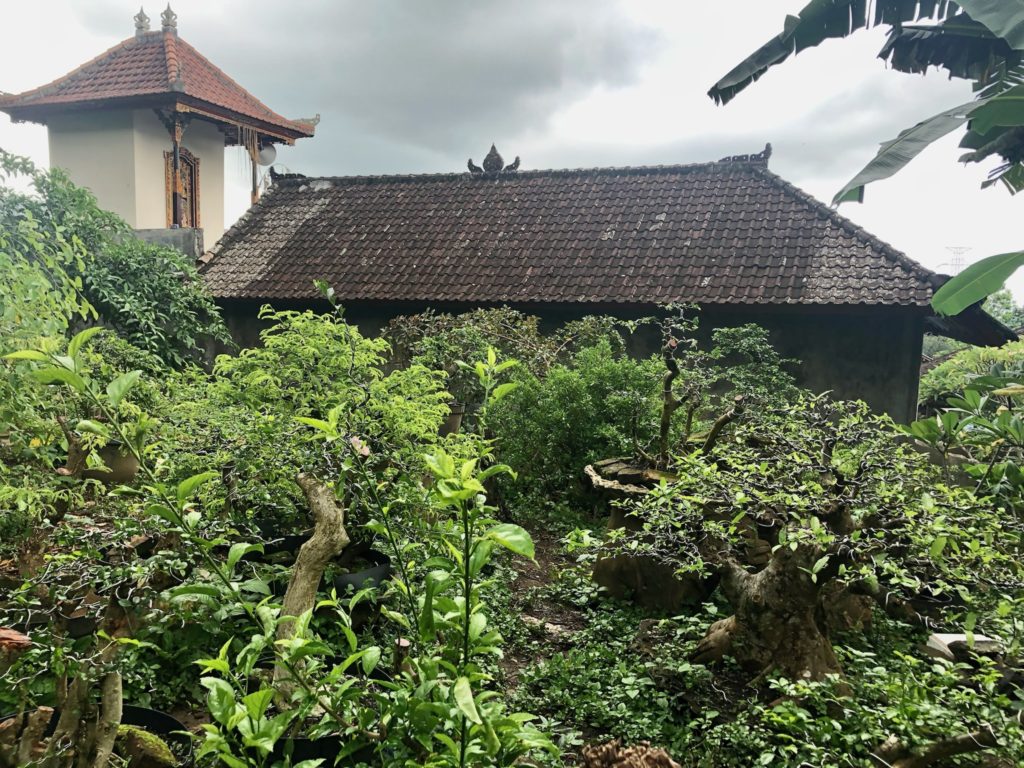
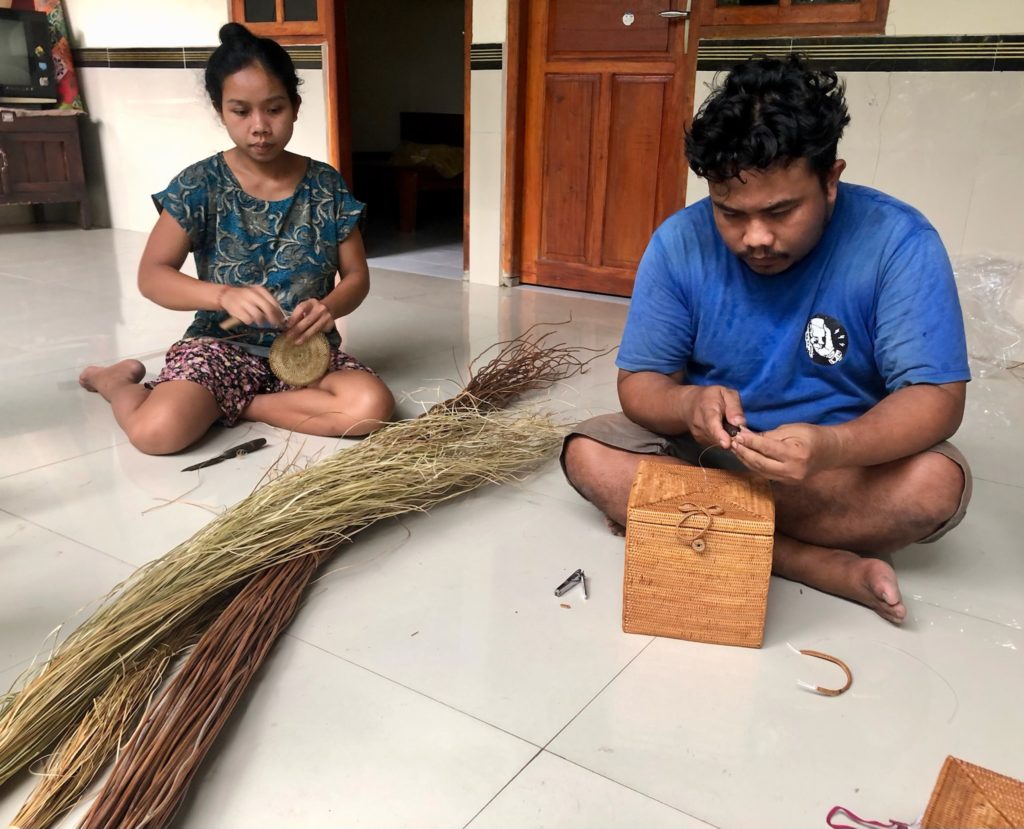
Did I really talk to my parents? Maybe. That is not the important question, as the ceremony worked for me. I felt relieved and my spirit elevated. A few days later, I went out and bought new clothes for both; and two small traditional baskets to hold the clothes. Have I done all the other things as instructed? Not really. Does this all make sense to me as a Westerner? Yes, but only on a psychological level of Jungian analysis, or cognitive closure rituals, or some other psychological tenets that are above my pay grade. But to the Balinese — such as my local friends to whom I relayed this experience — this story is a piece that fits right into the Bali cultural puzzle. Everything made sense to them. The locals thought the tenung was spot on, and how blessed I was to talk to my dead parents. Sure. Meanwhile, I have the holy water in hand. Come New Years Day; I am going to go for it, whole hog. I am collecting little pieces of banana leaf to present the meal offerings to my parents. I hope my dad likes his shirt.
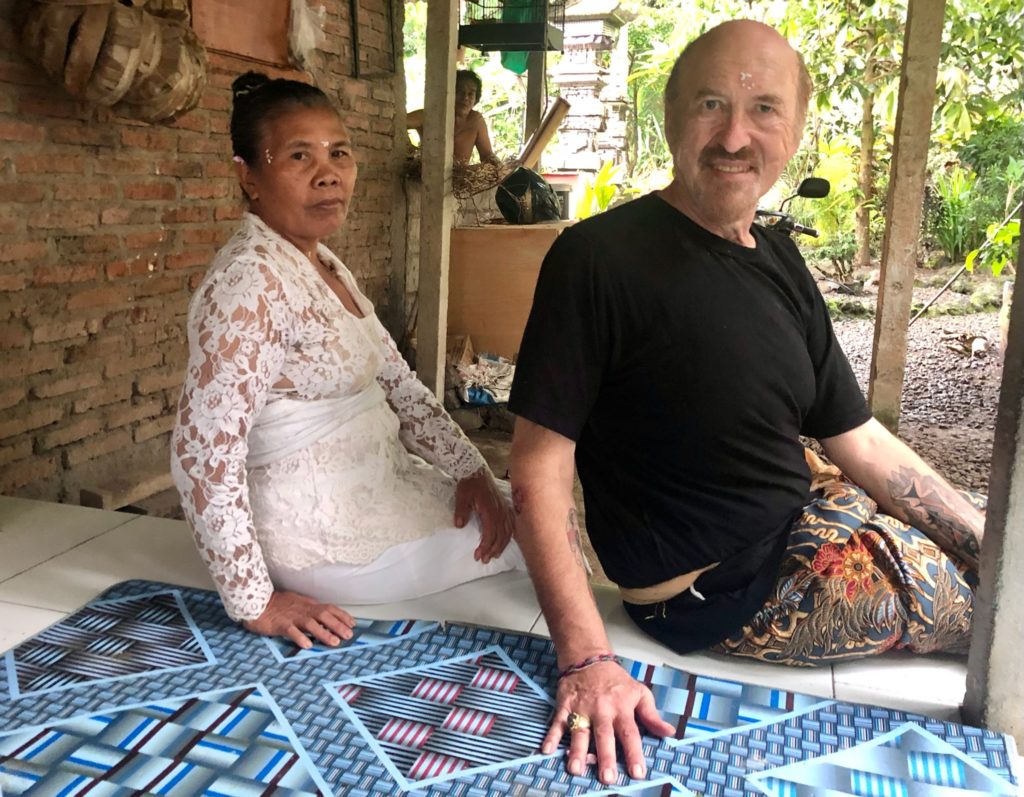
Look at how relaxed I was after the ceremony. The rice just above and between the eyes is visible. This rice cover where the pineal gland is located behind the forehead. This spot is aslo where a chakra is located in the Hindu tradition.

The tenung in her work station/altar after the ceremony
Balian Usada – Heal the Mind and Body with Counseling, Prayer and Herbs
I went to see this Balian with my friend and traditional acupuncturist, Tri, who is in the lower right photo. Tri is highlighted in my prior article on this website, “Enter the Balians …” mentioned above. This healing experience was a mismatch. People seek out this healer if they have major physical or psychic complaints. He prays over the patient and works up some mantra for the afflicted. The healer and patient do the mantra together and the patient takes it home to continue along with the yoga and meditation practice the healer recommends. He also give the afflicted a potion or lotion as needed, described above. However, the main focus of this treatment is counseling. Many people see this healer with emotional or psychic issues. He talks people through their situation and offers advice on how to live better in the future. I am not trying to be flippant, but I spent an hour with his guy. He seemed more like a traditional Bali life coach; but his concrete suggestions are couched in Bali terms — repeat this mantra, do yoga, meditate, and apply this paste to body aches, if the patient had a physical complaint. I did not even get a mantra probably because I am not a Hindu: just as well. The Balian does give out general counseling advice on how the patient should handle his problems. At least for me, his life advice and counseling suggestions was very dodgy
As mentioned, my treatment experience with the Balian usada below was at best a mis-match. Fundamentally, he is a counselor and healer for people in deep physical and psychic pain. Me, I just had the usual old man aches and pains. I had nothing that needed critical intervention; but then again, he offered nothing that showed me any special insight. I was told by Tri that he was a clairvoyant who could divine the past, present and future. In that light, I asked the Balian what I should do in the future as I am at a crossroads in life. He asked no further questions. He responded that I have many options and I just need to follow my passion. I offered follow-up information and questions so he could flesh out his answer: but he was done. That was his final wisdom for that topic. This quality of exchange continued. How long will I remain healthy – what is my health situation in the future? Answer (paraphrased): “This will help. Take this powder and apply it as a paste to your entire leg.” Putting aside the lack of any vision, his advise based on my current situation had the same empty quality. Overall, in addition to this paste panacea, his only insight was that I should meditate and do a certain style of yoga called raja yoga, which which I was familiar. I was not a satisfied customer. But the locals are lined up to see him. Using my most generous evaluation: The patient’s different culture (American) generated a different doctor-patient dynamic; which yielded a different levels of satisfaction, I guess.
As mentioned, the Balian gave me a powder to make into paste for my swollen leg. He offered no explanation as to cause of he swelling, or what this paste was, or how this paste would help. I asked these questions, but got no answers. I was instructed to apply this paste over my ENTIRE left leg daily and keep it one for at least one hour. Unlike the clairvoyant Balian, I know the reason the leg swells. Actually, he did not need clairvoyance: if he had asked my why; I would have told him. An herbal paste was not going to repair the damaged artery system caused by blood clots in that leg. I never used it.
Generally, I am familiar with this powder-paste remedy. I applied similar pastes given to me by Tri, who himself is a traditional healer. Tri is the guy on the motorcycle above that took me to the tenung. I used Tri’s pastes and his topical potions on small, external areas of my body for inexplicable pain, chronic pulled muscles، a serious gum infections, and the like. I was also twice given herbal concoctions to drink. I fixed right up quickly with the pastes and potions. Perhaps I healed because of he placebo effect. People have been given candy in pill form and told by the researches masquerading as doctors that the pills were powerful medicine. The “patients’ who received the M&M (candy) medicine recovered, as a group, much faster than ill people in a control group given nothing. Perhaps I healed because I believed; which I sort of did, but not whole heartedly.. Perhaps Tri has some special power and the pastes boosted his healing work (acupuncture, crystals, reiki, prayer) to give me a complete, holistic treatment. Then again, perhaps I healed because these potions contained medicines that would make my U.S.A. doctor nod her head in agreement. Or maybe the potions contain medicine Western doctors have not “discovered” yet.
Balian health tip – Don’t waste your money on betadine or Balian potions for minor skin wounds. Do you have skin rash from bad arak (the local moonshine); itchy bites from the local dengue mosquito; road rash from a scooter accident; or other skin cuts? If so, use this local medical hack. For minor to moderate skin wounds, those in the know use: automotive power steering fluid. Apply the power steering fluid directly to the wound. A little dab will do you.
Back to this Balian. He is a popular healer as people were lined up to see him. Everyone could see the Balian’s “treatment room”, otherwise known as his living room, through the large sliding glass doors and large windows. Commonly, traditional healers do their work out in open, and have no private treatment rooms. This healer and patient sat on the floor. They conversed around a low coffee table filled with: bottles and vials of his herbs and potions; and mantras written on scrolls of paper.
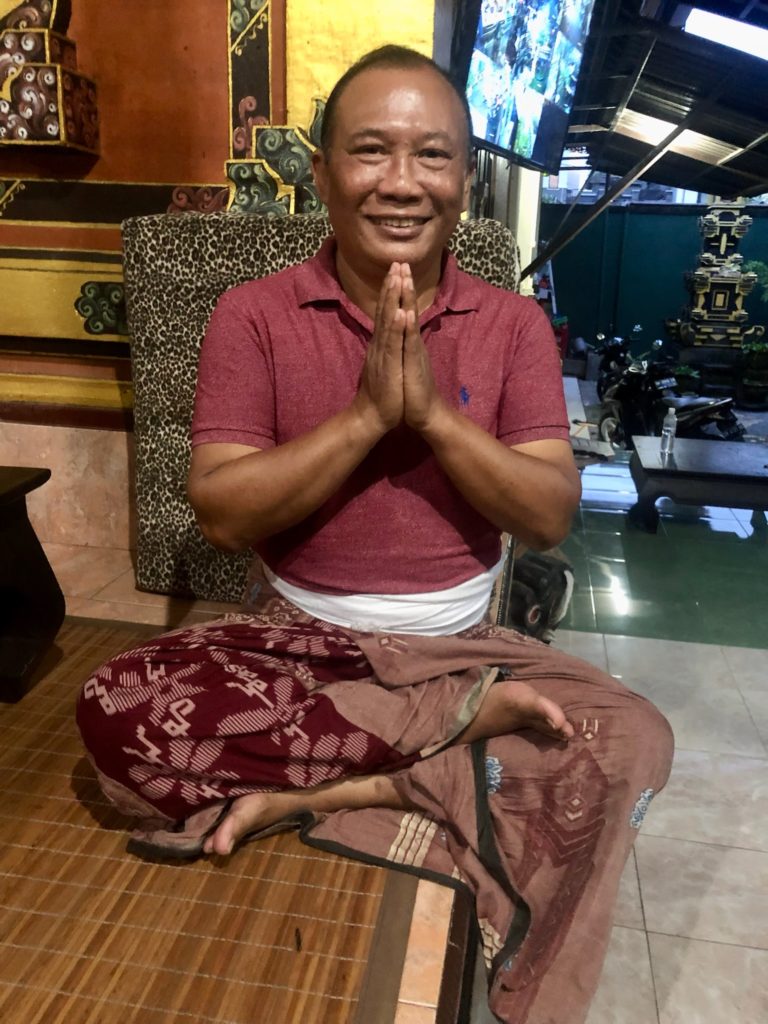

This May be an Oversimplification, but Here Goes — Two Ways to Understand Bali Culture: Magic and Both the “Seen” and “Unseen” World
The “Enter the Balians …” article sets out eight different types of Balians. Subsequently, I discovered that this specific list of eight, and the whole Bali world-view is very rubbery to outsiders; in the sense there is no singular perspective that fully encompasses Bali culture. There is a clear Bali comprehensive concept of the universe (the academic term is weltanschuung.) However, this world-view is explained very differently by different sources. The description the Balinese set out has great variety; and so do the analysis by foreign academics. Yet, this guiding concept is clear: The world view of traditional Bali is a fusion of indigenous animist customs melding into the more “modern” Hindu religion. “Stone Age Balinese Animism—the worship of the spirits of nature and ancestors—has changed little, even down to the present day.” These still vibrant ancient beliefs and customs predate Hinduism. The Hindu religion swept the Indonesian islands in the first century A.D. These early animistic beliefs go way back thousands of years (see guide-collective.com, Magic in-Bali)
THE ROLE OF MAGIC
Outsiders are always intrigued by a central aspects of Bali culture: the authentic place of magic in daily life. The roots of this reality is found in their Hindu-Animist religion. Balinese fervently worship the ancient spirits of the mountains, sea, and forests, and the like. The animists have carried over multiple pagan gods and demons. This animism feeds into a genuine belief in evil and good spirits; which in turn, leads to a preoccupation with magic—both black and white.
Thus, looking through the prism of magic is one way to understand Bali culture and how it supports traditional healers. Belief in good magic (white) and evil magic (black) permeates the lives of contemporary Balians. Magic in Bali is not to be confused with Western card tricks, abracadabra, or Penn and Teller. [good luck foreign readers]. The Balians believe that all people have the capacity for good or evil (white or black magic) and this accumulates spiritual energy, called sakti. The importance of enhancing positive sakti fuels the Balinese preoccupation with ritual cleansing, offerings, amulets, ceremonies, and ritual atonement. Individuals have a greater ability withstand evil influences; IF they have pure character and sakti [A mensch, an upright man of God. Sorry the Yiddish slipped in]. Those who are pure of heart, who also have great capacity for sakti, become priests or shamans or Balians. In contrast, Individuals with evil intent use sakti for harm through black magic. The practitioners of black magic can aspire to become Leyaks (black magic witches). Their mistress is the “queen of Leyak”, a widow-witch named Rangda, who takes the form of a flying head with a fearsome face. The head has entrails, (heart, liver and lungs) still attached. The enemy of the Leyak is the Barong. The Barong is described as a panther-like creature; the king of Bali spirits; the leader of the all that is good — including those with pure sakti. I have met Barongs and did not see the panther in them. In rituals and ceremonies, the Leyak and Barong battle it out in ritual dances while in a mild trance state.
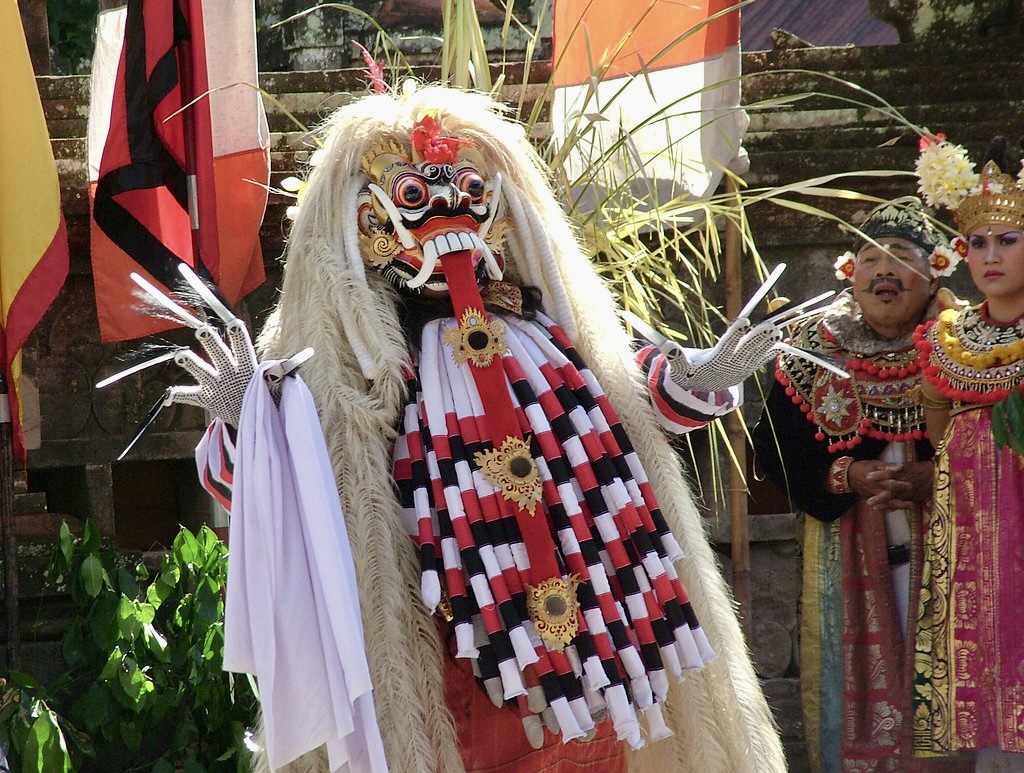
Above is Rangda, the Leyak queen, the evil nemesis of the Barong, the king of all that is good.
Leyaks have some similarity to blood-sucking monsters and shape shifters in other cultures. In the daytime, the Leyaks retain their original human form. At night, their Leyang self emerges. Their head and entrails break loose from their body and fly away. Leyaks haunt graveyards; feed on corpses; and look for pregnant women and newborns, so they can suck out the blood of the young. Leyaks are shape-shifters and can change themselves into animals, such as flying pigs. The Leyaks have an unusually long tongue and large fangs. Photo and text from Wikipedia
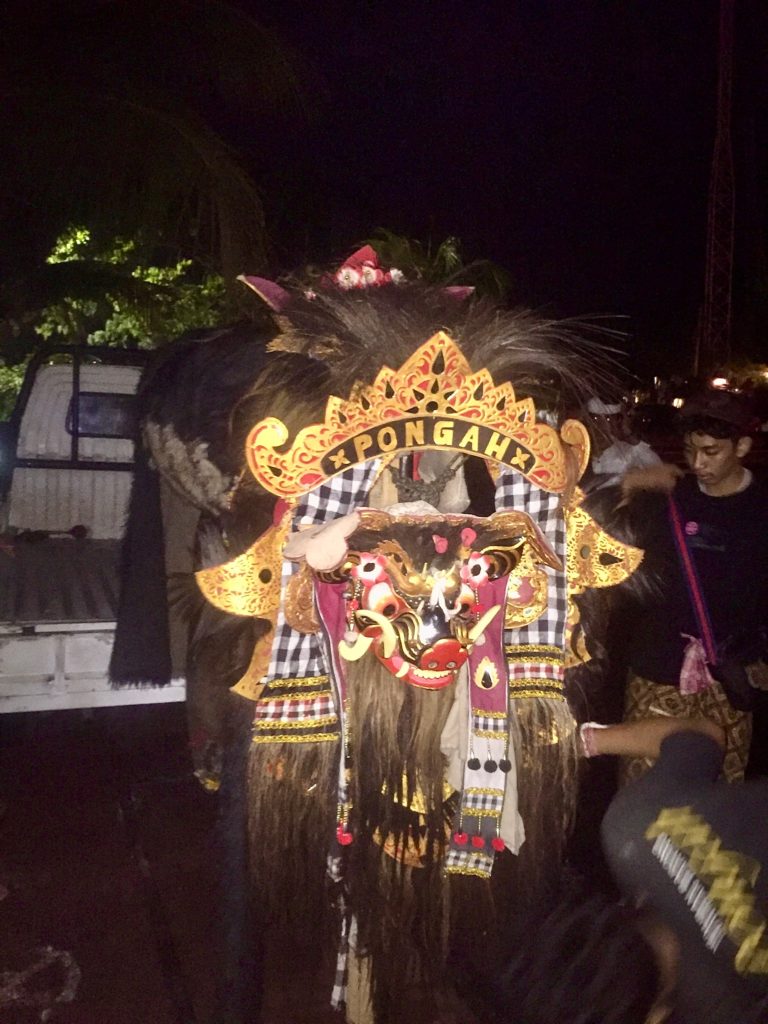

My Bali friends have warned me about black magic. I am making friends here and attempting to find someone to date. I was told never shake the hand of a date – if that someone originally from certain other regions of Indonesia, regions unnamed in this article. They may use black magic and put special oils on their hands that will rub off on my palm. These oils will cause me to fall in love so that I will give up all my money. I was also warned to never drink from open containers while in certain towns in rural Bali. This far-flung area is well known for black magic. A black-hearted local may put a magic potion in my drink to cast an evil spell. I immediately thought of “roofies”, the date-rape drug, but wrong cultural context.
In contrast, by using the correct local context, traditional healers draw on magic to help their patients. The healers fight black magic by tracking down evil influencers and black magic spells that afflict the patient physically and mentally. The healers use all their traditional medicine and magic to exorcise black magic at the root of the patient’s symptoms. They use most importantly, direct prayer to the gods and spirits; plus prayer directed to the patients. However, the Balians follow the old adage: “When you mentally treat, move your feet.” These Balians are busy. Depending on their specialty, they may be doing the following healing practices: clairvoyance of earthly events through time and space; psychically connecting to the spirit world; hands-on body work (such as radical massages); ritual cleansings; crystals healing; acupuncture; offerings; potions and lotions; and using family heirlooms or ancient manuscripts written on dried palm leaves called lontar — (see right side) or just old fashion divination — think throwing the bones or reading palms.
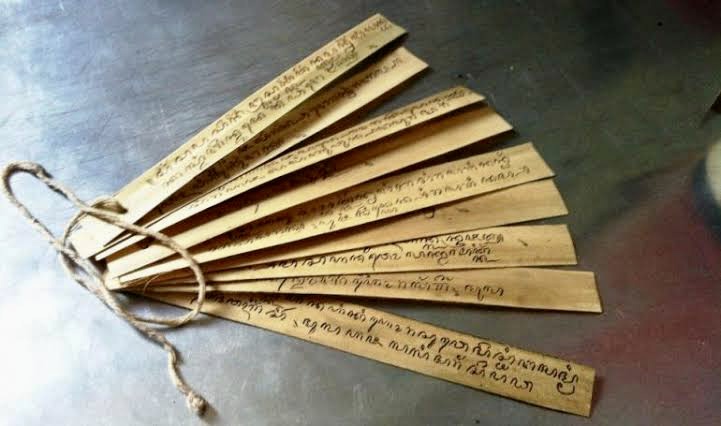
Above: Lontar. This quote from Wikipedia has been lightly edited for clarity: “The dried palm-leaf manuscripts, called Lontar in Indonesia, have been discovered in ancient, dedicated stone libraries at Hindu temples in Bali” Such dried palm leaf manuscripts were used in the Indian subcontinent and throughout Southeast Asia for many centuries. The use of lontar only ended with the rise of paper printing, typesetting, and book binding.
These efforts will have the effect of exercising black magic, and enhancing the effect of white magic. Thus, the healer restores the patients sakti to help insure that he remains pure of heart. In addition to the healer’s work,, the patient may be told that he has to make special offerings, perform certain prayers, undertake other rites, or use traditional potions and lotions, all to make the patient whole again. Most Balians cure ailments physical or mental in nature. However, some specialized Balians can do much more. Depending on their specialty, the healer may invoke white magic to: find lost objects; reveal the identity of evil doers; read the past or future; general prophesy; communicate with the dead, etc.
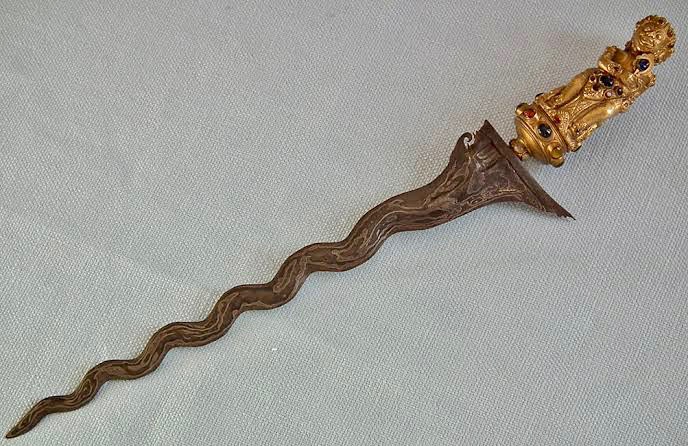
The Balian may use white magic to increase the patient’s spiritual sakti and also protect him from harm. Specific example include using white magic to create magic charms or spells to ward off evil spiritual or physical attacks. These charms can include amulets that make someone bullet proof or invincible to sharp weapons, like a keris — see picture on left.
Sekala and Niskala: The Seen and Unseen Worlds
Another way to understand traditional healers is through the contrasting “seen” and “unseen” worlds underpinning all of Bali culture. A static explanation is that sekala is the material world and niskala is the spirits world. No. The dynamic tension between these two worlds demonstrates the main concept of Bali life: balance. Bali culture focuses on preserving and enhancing balance in all aspects of our world: balance between God(s) and man; balance between man and nature; and balance between all people. The Balians maintain this inward and outward balance by bridging the gap between the seen world (sekala) and the unseen world (niskala). To this day, all bali traditions, cultures and ceremonies pivot on the interchange between the seen and the unseen.
Niskala is not somewhere out there in some vague alternate universe. Niskala be manifested here and now through many devotional practices. Examples of blending niskala into daily life include: temple rituals, offerings and prayer; immersive experiences in nature; or ecstatic states such as trance dancing (and all religious dancing involves some level of trance); or yoga practices much more involved than the standard hatha yoga of body positions. A Balian told me that such knowing awareness can results from bhakti yoga known for its “divine love mysticism”. While that mysticism sounds very exotic; Bhakti divine love flows out doing of good religious deeds — temple rituals, offerings, prayers and donations and the like.** A more psychically engaged way to bring about such balance is through more active practices such as meditation, raja yoga and spiritual pilgrimages. Thus, niskala is not something distant and detached from everyday experience. Rather, niskala can be demonstrated and influenced, in the here and now. Contrast this active engagement with the more removed concepts in the Western tradition, such as death, Heaven, or even the role of luck in our lives.) Balians mediate between the sekala and niskala; thus, allowing us to experience the spirit world in our daily earthly lives.
** A Balian and a few locals have told me (complained) that some people just go through the motions of attending temple, making offerings and the like, as an easy substitute for the harder task of seeking a true spiritual state. These folks mechanically perform the physical rituals, but are not spiritually enhanced; nor are they adding to the balance in their life or world.
In response to these observations in Bali, I silently laughed. This same empty ritualistism has been observed in many a member of Western faiths. How many Christians (or Jews or Muslims) perform the religious routines without mental engagement or spiritual introspection? Perhaps some people go through the motions because they are old habits, or due to family pressure. For example, the unengaged may mechanically attend religious services, donate money, and put religious symbols on their front door in the right season. Yet, the effect on their spirit is minimal or nothing. I am not picking on any one faith or any ethnic group; however, mafia members are the most egregious example along with church going narco-traffickers. Why are all the mafia dons and drug lords so devoted to their church, patrons of local religious events, big donors, etc. One clear answer is that such religious fig-leaf covering gives a veneer of respectability. Yet, I gather that many of these murderous criminals claim to have profound religious beliefs. How does that work?
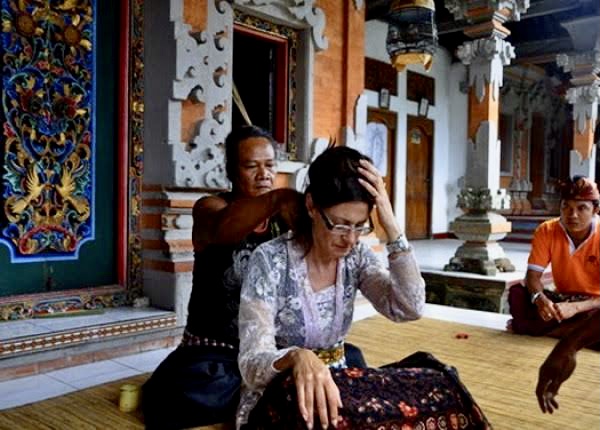
wonderful story and insight of the baily people. hope you benefited from the experience.
Zephyr,
Thanks to you I am learning more about Bali and Balinese culture than I probably ever would have even had I visited this lovely place for a typical tourist stay. I hope to go there one day.
Happy New Year!
Bob